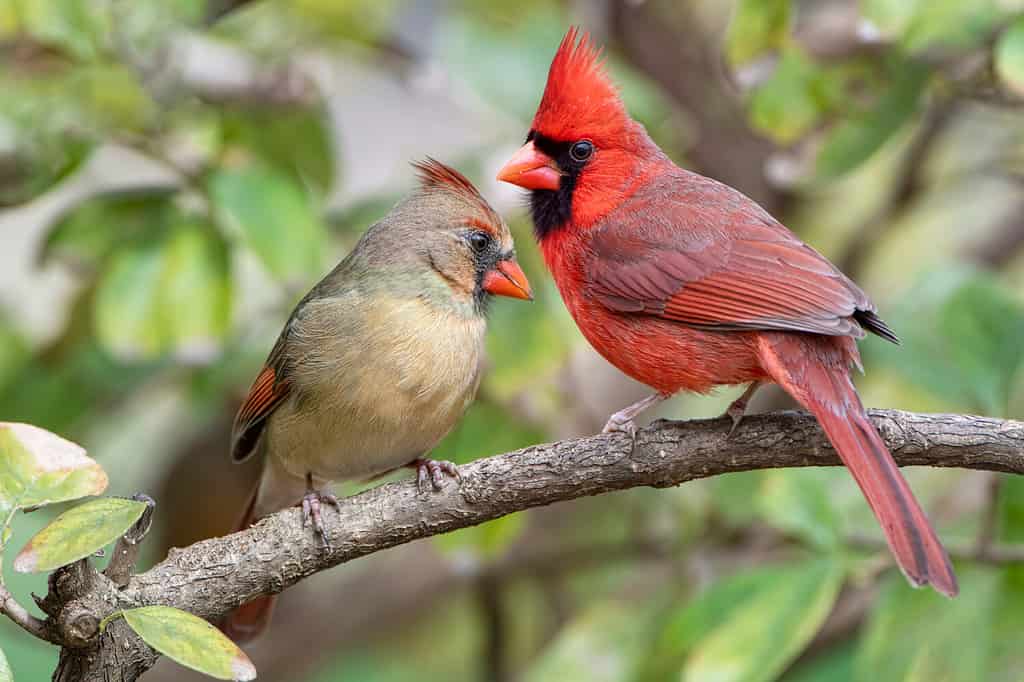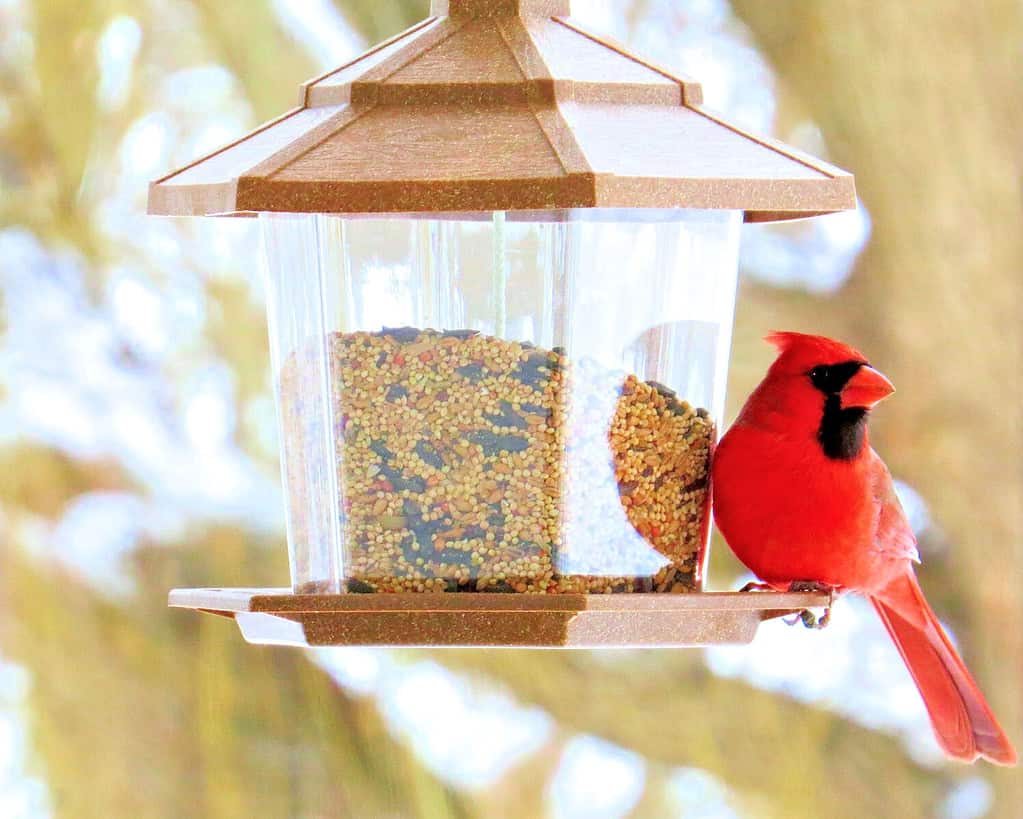How do you know if a cardinal’s in love?
The next time you see a pair of cardinals at the bird feeder, notice how they’re interacting. If a brightly colored male feeds a female a seed, this could be a flirtatious invitation. Eating “beak-to-beak” is usually a sign of affection in the bird world. The male will make an offering to the female, and if she accepts it, a courtship begins. Before long, the happy couple will find themselves with a nest full of eggs, just waiting to hatch. Follow along as we learn all about the fascinating world of cardinal eggs.
Cardinal Eggs Are the Size of Your Fingertip
Cardinal eggs are about the size of your fingertip. The small oval eggs range between .9 to 1.1 inches long and .7 to .8 inches wide. Rounding up can make it easy to remember the size. Think of cardinal eggs as being 1 inch long and 1 inch wide.
What Color Are Cardinal Eggs?
Cardinal eggs are off-white and speckled. Common cardinal egg colors include white, gray white, pale green, cream, and green white. Speck colors can be different shades of gray or brown. Eggs may also have blotches that are purple and or brown.
Symbolism of Cardinal Eggs
Cardinal eggs can symbolize new hope as you embark on a new chapter of life. Cardinals are often used as signs of hope, vitality, and restoration. Their red plumage is an uplifting reminder to keep truth alive in our hearts.
Did you come across unhatched cardinal eggs? There are a lot of interpretations in the world of cardinal spirit animal symbolism. Seeing unhatched cardinal eggs can symbolize a new beginning or opportunity coming to light. It can also be a reminder of how fragile and incredible life can be. With the right care, a tiny fragile egg becomes a bold, bright cardinal.
Where Do Cardinals Lay Their Eggs?

Cardinals are known to nest in shrubs, as well as low spots in trees.
©forest pictures/Shutterstock.com
Cardinals nest in shrubs and trees. If they choose a tree, the nest won’t be in the highest branch.
Cardinals prefer to be a bit closer to the ground than other bird species. It’s common for nests to be as low as 3 to 7 feet above ground. There are some cases where a cardinal might nest higher up, going as high as 40 feet. But if there’s a prime low spot, they’ll choose it first.
Here are some of the cardinal’s favorite nesting spots:
- Pine trees
- Elm tree
- White spruce
- Hawthorn shrub
- Privet shrub
Nests are a carefully crafted open-cup design. Nesting materials include things like grass, leaves, twigs, hair, and bark.
What Eats Cardinal Eggs?

Blue Jays and brown cowbirds occasionally steal cardinal eggs and eat them.
©FotoRequest/Shutterstock.com
There are plenty of predators who will slither, crawl, or fly at the opportunity to eat a cardinal egg. Milk snakes, pilot black snakes, and black racers are all known to dine on unhatched cardinals. As are chipmunks, fox squirrels, bald eagles, hawks, owls, and domestic cats. There are even smaller birds that target cardinal eggs. While not common, brown cowbirds and blue jays will sometimes steal (and eat) cardinal eggs.
Eggs First Appear in March
If you find a cup-shaped nest with off-white speckled eggs, they might belong to a cardinal. Cardinals tend to lay their first clutch of eggs in early spring, right around March. By May and June, they’ll lay their second clutch, and possibly even another after that. Each clutch usually has four to five eggs.
Eggs Hatch in 12 to 13 Days
Cardinals sit on their eggs for just under two weeks. Not all of the eggs are guaranteed to hatch. If there’s a clutch of four to five eggs, it’s not uncommon for only three or four of the eggs to hatch.
Breaking Free
When the egg’s ready to hatch, the tiny bird inside uses its egg tooth to make a small hole inside the egg. The egg tooth is a sharp point on the end of the baby bird’s beak.
After the shell’s pierced, the baby starts moving around inside the egg. Eventually, the tiny bird will stretch enough to crack the egg in two.
The entire hatching process is exhausting and can take up to a half hour to complete. Hatchlings will then stay in the nest for about nine to 13 days.
Do Cardinals Abandon Their Eggs?
Many birds, like cardinals, are considered good, and even tenacious parents. This means they won’t leave their nest unless they absolutely have to.
What could cause a bird to leave a nesting site? If the nest becomes unlivable or is under extreme threat, parents might abandon unhatched eggs. Examples include things like infestations. For instance, if ants are overtaking the nest, the cardinal parents might jump ship. However, if something scares the birds, that’s not necessarily enough to make them leave.
Do Cardinals Mate for Life?

Cardinals are monogamous and sometimes stay together for life.
©Bonnie Taylor Barry/Shutterstock.com
Do cardinals really mate for life? The answer isn’t a straight yes or no. Some cardinal couples stay together forever, others don’t. Here’s how it works:
Cardinals are monogamous birds. They form a pair bond where one male mates with one female. In other words, when a cardinal finds a partner, that’s the only partner they spend time with. It’s typical for cardinal couples to last a year. However, there are accounts of couples lasting for multiple years.
Sometimes cardinals separate at the end of the breeding season. The bonds can also end if one of the birds dies. A typical cardinal lifespan is anywhere from three to five years. However, there are special accounts of cardinals living as long as 15 years.
Male Cardinals Are Good Fathers
Male cardinals are famous for being good fathers. They’re some of the most attentive avian dads, sometimes raising up to three broods in a single year.
The fatherly involvement starts from day one, with nest building. Even though the female does most of the construction, males still play a big role in gathering material. Their next moment to shine comes when the eggs arrive. The male cardinal fiercely defends the nesting territory so the female can focus on keeping the eggs warm.
Along with guarding the nest, males are also responsible for keeping everybody fed. Male cardinals will bring back all sorts of insects to feed the female while she incubates the eggs. This responsibility continues when the hatchlings bring more hungry mouths to the table. Females help feed the babies too, but males do the brunt of it. This helps free the female up so she can take off to start a new nest site and raise another brood.
Encourage Cardinals in Your Yard

Birdfeeders with big platforms encourage cardinals to land and eat.
©MLHoward/Shutterstock.com
How can you attract cardinals to nest in your yard? It all starts with providing a safe environment that’s also convenient. Cardinal parents will be looking to set up their nests in locations that have water, food, and shelter. Even if you don’t have a lot of trees, your yard setup can still encourage bird activity. Remember, cardinals love nesting in shrubs.
Birdfeeders are a great way to attract cardinals. Start by picking a spot in your yard where the birds can access the feeder, but not your pets. You’ll also want to do what you can to deter squirrels and raccoons. Hanging the feeder six feet above ground should help. Finally, look for square or large platform feeders so it’s easy for the cardinals to land.
The photo featured at the top of this post is © Steve Byland/Shutterstock.com
Thank you for reading! Have some feedback for us? Contact the AZ Animals editorial team.






